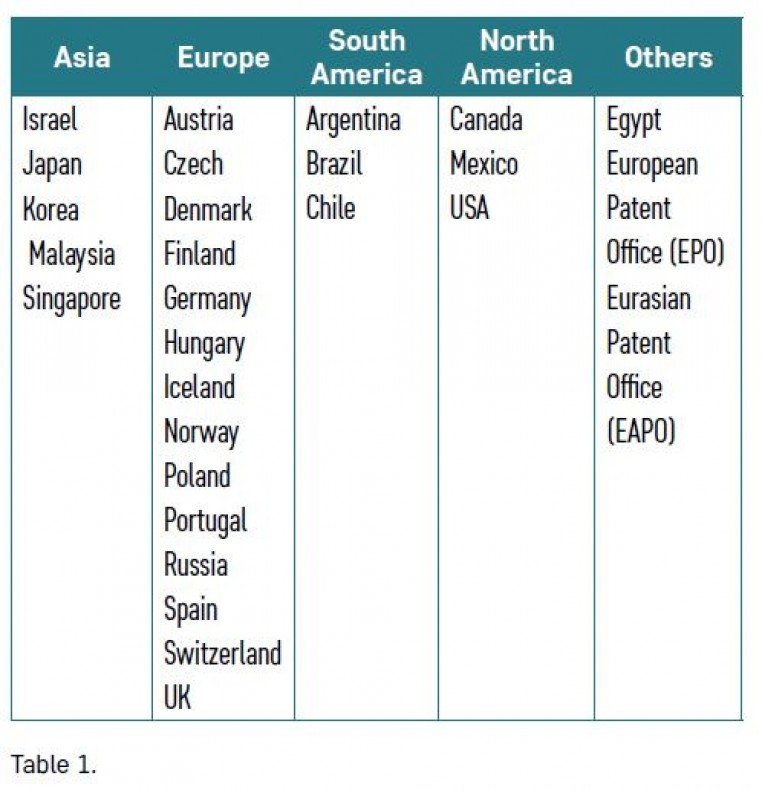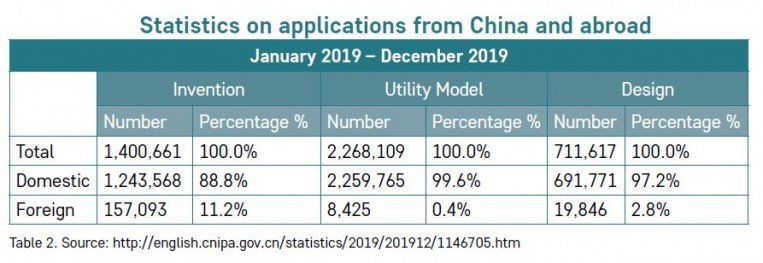In 2019, foreign applicants filed 157,093 invention applications and 8,425 utility model applications, but those filed by domestic applicants were 1,243,568 and 2,259,765, respectively. For utility models, the number of applications filed by foreign applicants only accounts for 0.4% of applications filed, and the ratio between invention and utility applications filed by foreign applicants is around 19:1. This shows that fewer foreign applicants make use of the utility model system to protect their technologies, which may be caused by the perception that the level of innovation in utility model patents is relatively low. However, it is not helpful to stick to this misperception and to ignore benefits provided by the utility model system. In China, inventions mean new technical solutions proposed for a product, a process or the improvement thereof, and utility models mean new technical solutions proposed for the shape, structure, or their combination, of a product.
If a technical scheme meets criteria of both an invention and a utility model, it is highly recommended to file patent applications for both invention and utility model simultaneously for the technical scheme. Although the term of a utility model patent is only 10 years, which is much shorter than that of invention patent, a utility model patent has the following advantages: 1) unlike an invention patent, substantive examination will not be required in respect of an application for utility model. As a result, the entire examination will typically take six to 10 months, which means that a utility model patent may be granted easier and much faster, and companies may enjoy patent rights at an earlier time. Even though it takes two months to obtain a patent evaluation report for enforcement, the total time spent is much less than that of an invention patent, which may be two to four years; 2) the criteria in relation to inventiveness of an utility model patent is lower than that of an invention. This means that, for the same technical scheme, the stability of a utility model patent right is greater than that of an invention patent. In other words, it is more difficult to invalidate a utility model patent than an invention patent. This is beneficial to protect the relevant technology. If the counterpart invention patent is granted at a later time, the applicant may abandon the utility model patent and maintain the invention patent only. Even if the application for an invention patent is rejected, utility model patent may not be invalidated due to use of the prior references cited in the invention application as the criteria with regard to inventiveness are different.
Changes in enforcement and coping strategies
On November 14, 2019, CNIPA issued the Notice Concerning Model Creation of Administrative Adjudication on Patent Infringement Disputes, by which local IP administrative authorities are required to push model creation work of administrative adjudication so as to make administrative adjudication play an important role in settlement of patent infringement disputes. Pursuant to the notice, administrative adjudication on patent infringement should be enhanced by publicizing the advantages, efficacy, and typical cases in connection with administrative adjudication of patent infringement, encouraging and guiding the relevant right holder to resolve patent infringement disputes by administrative adjudication, and introducing new methods in the procedure of administrative adjudication. For example, for a design or utility model patent infringement case in which the petitioner has submitted a patent evaluation report at the time of filing the case, based on statements and cross-examination of evidences by the parties involved, the relevant administrative authority may handle the case by examining the records without hearing.
Besides, for a case with sufficient preparation before hearing and comprehensive evidence collections, it is encouraged to pronounce a judgment immediately following the oral hearing. Further, it is encouraged to employ professional technicians to take part in the trial of the case by assisting in ascertaining technical facts and providing consulting opinions.
If a request for invalidation has been filed in connection with the involved patent, the relevant local IP administrative authority may contact the Reexamination and Invalidation Examination Division of CNIPA to perform a joint trial. Therefore, the procedure of administrative adjudication and the procedure of invalidation of the patent may be eventually merged. It is seen that, in the future, patent infringement disputes will be settled in a more convenient and cost-effective fashion through administrative adjudication.
In my opinion, if the primary purpose is to stop patent infringement earlier without focusing on potential damages (usually limited), and if the determination of infringement is relatively direct without need of special experiment analysis, administrative adjudication should be a preferred way to resolve patent infringement disputes, especially when the infringer is located in a developed province, as the local IP administrative authorities of developed provinces have rich experiences in handling patent infringement cases. Also, patent examination collaboration centres have been established in such provinces as Beijing, Tianjin, Guangdong, Jiangsu, Hubei, Sichuan and Henan to assume responsibility for patent examination. As a result, local IP administrative authorities may easily and conveniently access the examiners in such centres as technical and IP professionals for their consultancy in order to ascertain technical facts and make accurate determinations. This may significantly reduce the possibility of lawsuits brought to courts by the involved parties, and the dispute may be resolved in one proceeding.
However, if one of the purposes is to obtain payment of damages, it is advisable to settle patent infringement disputes by court proceedings. Although local IP administrative authorities may make mediation on damages according to the Guidelines for Administrative Mediation of Patent Disputes issued by CNIPA in July 2020, depending on our experiences, it is very difficult for concerned parties to reach consensus on damages by mediation, especially when the infringer is a small entity or an individual.
In general, the Chinese IP system is developing. For an international company, it is not sufficient to develop an IP strategy for China solely from its own perspective. Rather, it needs to consider carefully the ongoing changes in China’s IP system as they have an impact on a valid IP strategy.











